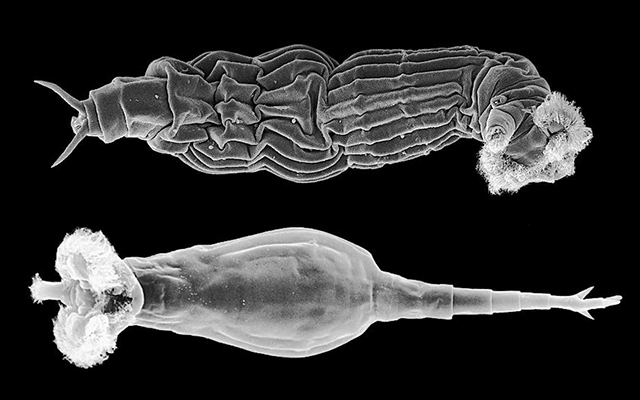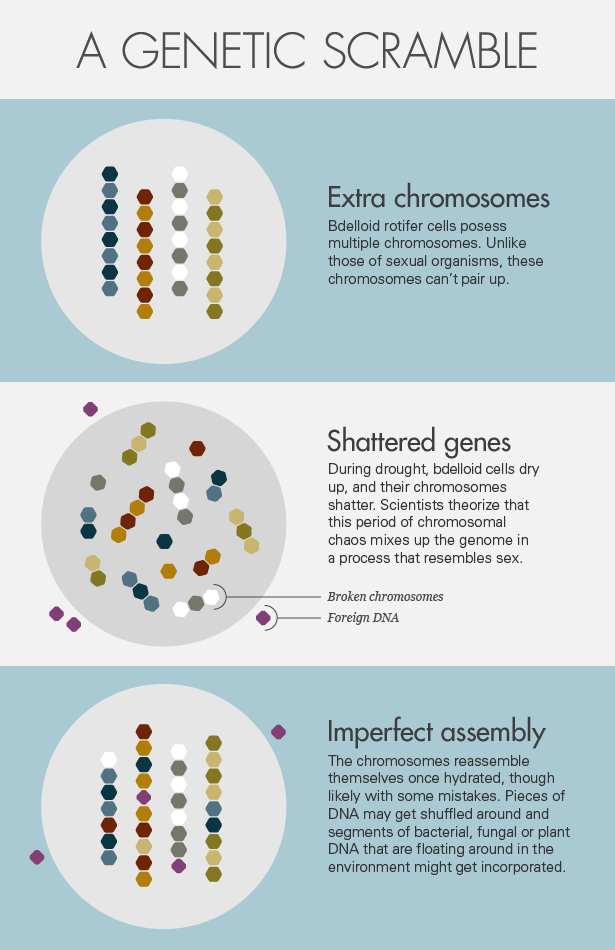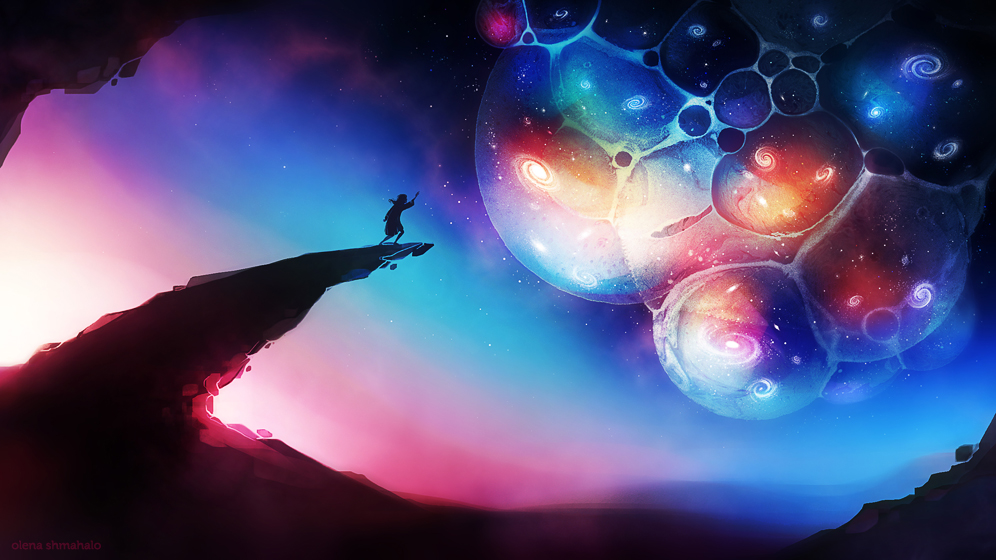Ancient Survivors Could Redefine Sex

If all the animals on Earth could offer a single lesson for long-term survival, it might be this: Sex works. Out of the estimated 8 million animal species, all but a smattering are known to reproduce sexually, and those that don’t are babes in evolutionary terms, newly evolved animals that recently lost the ability to mate. “Sex must be important — if you lose it, you go extinct,” said David Mark Welch, a biologist at the Marine Biological Laboratory in Woods Hole, Mass.
Yet even though sex is the overwhelmingly dominant method of animal reproduction, scientists aren’t sure why that is. Mark Welch estimates that researchers have developed around 50 to 60 hypotheses to explain the primacy of sex in the animal kingdom. Some of these theories have been biological battlegrounds for more than a century.
Studying the exception could help scientists understand the rule. And the exception in this case is a class of creatures called bdelloid rotifers (the “b” is silent), microscopic swimmers that split off from their sexual ancestors 40 million to 100 million years ago.
These bizarre animals are chaste survivors in a carnal world. They can withstand more radiation than any other animal tested to date. They can inhabit any surface that gets wet, from damp tree lichens to evaporated birdbaths. And without water, they hunker down in a state of total desiccation and then snap back to life with just a drop of liquid.
A recent analysis of the bdelloid genome has begun to reveal how asexual mechanisms can mimic the DNA swapping characteristic of sex, perhaps even surpassing it in effectiveness. The new work has shown bdelloids to be so good at generating genetic diversity that some researchers now question the very definition of sex, with some arguing for a more expansive one that doesn’t require the orchestrated swapping of genetic material. Others think that even if the traditional definition of sex remains intact, the unique genetic strategies of the bdelloid rotifer will illuminate the mechanisms that make sex such a successful evolutionary strategy. “If we can figure out the problem that bdelloids solved,” said Mark Welch, who has been studying rotifers since the 1980s, “we can figure out why sex is important.”
Why Sex Is Popular
Reduced to its most basic form, sex is about the exchange of DNA. At the heart of this transaction is a process called meiosis, where chromosomes inherited from each parent pair up and swap pieces. The chromosomes are then divided among daughter cells. The result is a set of cells whose genome is different from that of either parent.
The benefits of this exchange seem obvious. The genetic shuffle creates a diverse population, and a diverse population should be better able to cope with a changing environment. This basic idea was first proposed by the German biologist August Weismann more than a century ago.
But sex also has substantial drawbacks, presenting something of a puzzle to evolutionary biologists. A sexual organism passes on only half of its genes, which significantly reduces its genetic legacy. And because sex shuffles the genome, it breaks up genetic combinations that work well. In addition, an animal that wants to mate must spend time and energy searching for a mate. Once that match is found, the act of sex carries the risk of sexually transmitted diseases, a very real danger in the natural world.
Given the drawbacks of sexual reproduction, we might expect the animal kingdom to be filled with both sexual and asexual creatures. But this is not the case; sex overwhelmingly predominates. “After hundreds of years, we still don’t know what’s so important about it,” Mark Welch said. “One of the big quandaries is the contrast between the apparent short-term advantages of asexuality versus the apparent long-term advantages of sex — how do you even get the chance to reap the long-term benefits?”
AkiraFlickr
Video: Commonly known as wheel animals, rotifers feed by means of a ring of slender projections called cilia, which appear to spin like a propeller as the animal draws in water filled with a meal of dead bacteria, algae and other detritus.
Out of all the hypotheses biologists have developed, Weismann’s basic premise — that sex gives animals the variation needed to deal with a changing environment — is still a top contender. In the century since he proposed it, theoretical biologists have devised specific mechanisms that would explain why it works. For example, sex might unite two important adaptations. One group of animals might develop a tolerance to high temperatures, for example, another to a specific toxin. Without sex, those two capabilities would be unlikely to come together in one species.
According to a hypothesis known as the Red Queen, which is sometimes considered a variant of Weismann’s proposal, sex might help animals in their eternal arms race against pathogens. The genetic shuffling in sexual reproduction would help them quickly evolve defenses against rapidly morphing enemies. (The name of the hypothesis derives from a passage in “Through the Looking-Glass,” by Lewis Carroll, in which the Red Queen tells Alice to run as fast as she can in order to stay in the same place.)
Another theory, called Muller’s ratchet, first put forth by the geneticist Hermann Muller in the 1960s, suggests that sexual reproduction helps rid the genome of harmful mistakes. In asexual organisms, new mutations occur in each generation and are passed on to the next, eventually driving the species to extinction. (It’s called a ratchet because, in theory, once the genome develops an error, it’s stuck — there is no plausible way back.) The genetic shuffling that occurs during sex could act like a dust cloth to wipe away the offending mutations.
Scientists have accumulated evidence in support of each of these hypotheses. Yet researchers find it difficult to test any of them directly. Bdelloids offer a complementary approach. “Understanding how they cope without sex will help us understand why sex is important,” said Diego Fontaneto, a biologist at the Institute of Ecosystem Study in Italy.
Jumbled Chromosomes
Bdelloids have been squirming beneath scientists’ microscopes since 1696. In all that time, no one has spotted a male. (Sexual rotifer varieties have clearly distinguishable males, with a penis-like organ and sperm.) No one thought much about this curious void for nearly 200 years, until biologists first began to study asexual reproduction in animals, Mark Welch said.
Such a long absence of males is telling, but it’s not definitive proof of asexuality. Other organisms that were once thought to go without intercourse were later found to mate under rare circumstances, often triggered by stress. “There have been many putative asexuals, but when people looked more closely, they did find some kind of secret sex going on,” Mark Welch said.
Beginning in the late 1980s, Matthew Meselson, a renowned biologist at Harvard University, argued that perhaps the bdelloid genome could be used to test the organisms’ asexuality. Most animals have chromosomes made of two nearly identical copies of each gene, a consequence of the pairing and mixing that goes on during meiosis. In asexual animals this mixing wouldn’t happen, and the two copies should remain stubbornly distinct.
Just as the Human Genome Project was wrapping up in 2000, Meselson and Mark Welch, who had been Meselson’s graduate student, published the first results of their exploration of the bdelloid genome. They found that bdelloids often had two very different copies of their genes.
But the bdelloid genome would soon reveal even more interesting secrets. The animals often had not just two copies of a gene, as humans do, but four copies. Scientists began to suspect that at some point in bdelloids’ evolutionary history, the entire genome replicated, leaving the creatures with an extra set of chromosomes.
What were these chromosomes doing? To investigate, researchers had to sequence the entire genome. (Previously they had examined single genes or bits of chromosomes.) In 2009, a team that included Mark Welch and Karine Van Doninck, a biologist at the University of Namur in Belgium, received a grant to undertake the work. What they found was more intriguing than they anticipated.
The bdelloid genome is composed of more than just bdelloid genes. It is a Frankensteinian collage of foreign DNA. Nearly 10 percent of the bdelloid’s genome comes from outside the animal kingdom entirely, with fungi, plants and bacteria all contributing. This percentage is much higher than for other animals. In this regard, bdelloids more closely resemble bacteria, which frequently incorporate alien DNA into their genomes, a process known as horizontal gene transfer.
What’s more, the bdelloid chromosomes are a jumble; bits and pieces of them have been moved around like a mismatched puzzle. “The highly rearranged chromosome was new and unexpected,” said John Logsdon, an evolutionary biologist at the University of Iowa who was not involved in the project. “It’s very unusual.”
Nature sometimes jumbles a chromosome, but major rearrangements in sexually reproducing organisms render the unlucky individual sterile: If the maternally inherited chromosome is structured A-B-C, it can’t pair with a paternally inherited chromosome that’s ordered A-C-B. (Some hybrid species, such as mules, are sterile for a similar reason. The chromosomes from the horse mother and donkey father are mismatched.)
The full genome sequence provided the most direct evidence yet that bdelloid rotifers are asexual: No organism with such a mismatched set of chromosomes could possibly go through traditional meiosis. “Over millions of years, the genome has undergone so many rearrangements it’s no longer possible for the chromosomes to pair,” Mark Welch said.
These two striking properties — incorporating large amounts of alien DNA into their genomes and rearranging their own DNA — might help bdelloids surmount the problem of genetic diversity that plagues asexual animals. “There are quite a few ways in which asexual organisms can apparently overcome some of the disadvantages” of not having sex, said Bill Birky, an evolutionary geneticist at the University of Arizona, who was not involved in the sequencing project. Bdelloids’ ability to take up foreign DNA can potentially give them new powers, allowing them to break down a toxin, for example. Copying and replacing pieces of their own chromosomes can sometimes boost the effect of beneficial mutations and remove harmful ones, defying Muller’s ratchet.

Moreover, bdelloids’ extra pair of chromosomes might generate additional genetic diversity. The redundant pair of chromosomes provides a new reservoir of genetic material that is free to evolve and take on new functions, which might help the bdelloids cope with changing environments in the future, Fontaneto said.
Yet not everyone is convinced that bdelloids are entirely asexual. “To me, the evidence is not completely slam-dunk in terms of demonstrating asexuality,” Logsdon said. “There are a bunch of weird things about the genome, but are they directly related to putative asexuality or a consequence of other things?” Even though it’s difficult to imagine how bdelloids’ garbled chromosomes might pair for meiosis, they could have “some very unusual or infrequent process by which chromosomes pair and segregate,” Logsdon said.
A New Kind of Sex
So far, data from the bdelloid genome suggests that these creatures have survived by generating lots of genetic diversity through asexual means. But researchers haven’t been able to prove it. Nor have they shown that this variation is enough to mimic sex. “It gets back to the question we keep asking theoretical biologists — how much sex is enough?” Mark Welch said. In other words, how much genetic scrambling does an organism need to do in order to mimic the benefits of sexual reproduction? To answer that question, scientists will need to measure genetic variability among a number of bdelloids and compare it to sexually reproducing populations.
Scientists don’t yet have enough data to distinguish among various theories for why sex is so important — and it’s possible that a number of these potential mechanisms contribute to bdelloids’ lengthy survival. “One thing that gets theoretical biologists upset is to suggest many [theories] might be true,” Mark Welch said. “But there’s no particular biological reason that many theories can’t be right.”
Perhaps the more interesting question is how bdelloids succeeded when so many other asexual species have failed. Van Doninck is now exploring whether their striking ability to survive drought is the key to their long-term asexual existence. When a bdelloid dries out, its genome shatters into fragments, which the animal can stitch back together again once it’s rehydrated. It’s possible that this remarkable DNA repair function allows bdelloids to scramble their chromosomes and to take up foreign DNA floating around in the environment, fixing these fragments into the genome as it recomposes. The result: a kind of supercharged genetic recombination without sex. Researchers are testing this idea by exposing bdelloids to rounds of radiation and desiccation and analyzing how the genome rearranges itself.
Early evidence hints that bdelloids could also assimilate DNA from other members of their own species. That’s particularly significant because it would resemble traditional sex. “If they do genetic exchange among each other, then they have some kind of sex,” Van Doninck said. That process wouldn’t require meiosis, an essential component of sexual reproduction as currently defined. But in Van Doninck’s view, it might be time to broaden the definition. Perhaps sex can be defined simply as a genetic exchange among members of the same species. Bdelloids might be the exception that changes the rule.
This article was reprinted on BusinessInsider.com.



